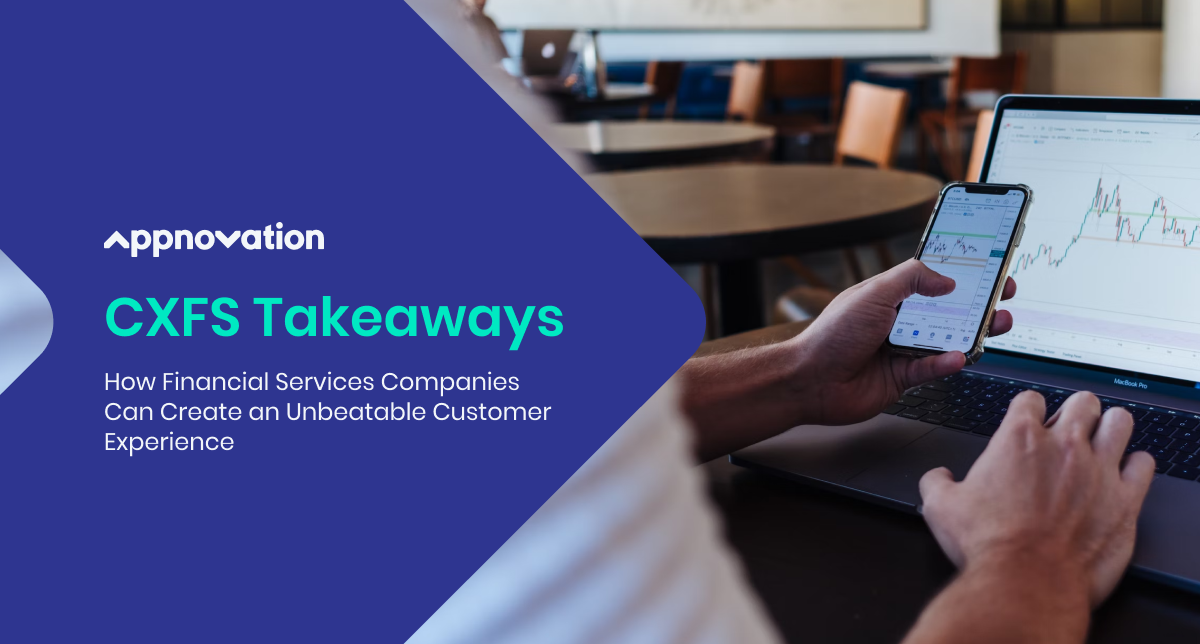How Financial Services Companies Can Create an Unbeatable Customer Experience
A Greek philosopher said, “change is the only constant in life.” And, it turns out, it stands true for business too. Particularly for financial services, where the surge of tech and considerable shifts in consumer behavior were accelerated during the COVID-19 pandemic. Change is one thing industry leaders can count on.
At a recent CXFS conference for customer experience innovators in financial services, Appnovation’s own VP of Business Solutions, Riccardo Zane, was inspired to see the vast array of marketers thinking beyond the effects of the pandemic and meaningfully asking, “where do we go from here?” Along with some fantastic leaders from across the industry, he participated in an opening panel that went beyond analyzing the “new normal” and delved into industry-wide fatigue over trying to define it.
An inspiration point that has always guided Riccardo is to fully embrace change — not just to expect and prepare for change, but to relish it. While the current pace of change may not necessarily be a “new normal” in the long run, it is undoubtedly the norm right now.
And that’s something everyone can be excited about.
Here are three takeaways Riccardo shared at his CXFS panel earlier this year. They reflect the cornerstones of the current strategies that are top of mind as organizations continue to navigate the rapid pace of change in financial services.
Understand the balance between personalization and creepiness
At first glance, it can seem like there’s no such thing as too much personalization. The more personalized, the better, right? Not exactly.
There is a crucial intersection between marketing personalization and your audience’s interpretation of their privacy. You should definitely use data to provide value to your customers, creating experiences that impress them and build trust. But personalization falls on a spectrum that needs to consider customers’ opinions of their experiences.
There is a moment where personalization can tip from friendly and helpful into creepy, and it’s up to marketers to deeply understand their audiences and know where to draw the line.
The teams at Appnovation believe that personalization must also have a purpose. In recent work with a client, customer testing was underway for a personalization predictability mechanism with an integrated UX and UI experience. At first, everyone was thrilled with how fast it worked, taking complex data and surfacing customized recommendations in just one second. But the users didn’t trust that the information presented was accurate or meaningful because of how quick it was. After delaying the response by eight seconds, user engagement immediately jumped by 3x. It was an excellent example of how the experience of personalization contains many facets and is never only about speed or accuracy.
Your customers don’t think or behave in channels. Neither should you.
Riccardo shared that he’s been chasing the holy grail of channel attribution for 30 years and has never found it. That’s why a more holistic, customer-centric approach is so important. Your customers don’t interact in single channels, and your strategy shouldn’t expect them to either.
Channels need to be connected and aligned, and this requires an evolution not only in how you operate, but how you think. Not just at an omnichannel level, but as an omni-journey, where you can see what the whole journey looks like to each individual in your ideal audience set.
Cross-channel integration and fulsome journey mapping — based on what your customers actually do, not what you think they do — is critical. Once you understand what they’re doing, you can more accurately strategize how to build customer experiences for where they are now, then guide and incent behaviors to where you want them to be.
Predictive analytics can take you to the next level. How do you predict an omni-journey? With deep data, you can create the end goal of a seamless experience. You’ll discover the actions you can implement to connect strong messaging with relevant engagement.
The brand that empathizes the most, wins
Empathy is one of the most powerful tools at a financial service company’s disposal. At Appnovation, clients begin massive customer experience transformations founded on empathetic approaches.
A deep connection lies between customer experience and employee experience. How you inspire, engage, and motivate your teams directly impacts how they will apply the same qualities in their work. That reflection is even more critical if they’re customer-facing and on the front lines in branches or other service roles. Give these teams the insights and empower them to use all of it for the benefit of customers, live and in the moment. This includes process management, data, insights and dashboards — whatever they need to prove to customers they have what it takes to get the job done.
When creating solutions for customer experience, Appnovation has embraced empathetic foundations into the core of our work with clients. What used to be called a “discovery foundation phase” in the initial strategic work is now called an “empathy phase.” Our teams take the time to recognize, understand, and fully connect with your audience through detailed insights into what they want and need.
You must understand customers first — only then can all those pieces fit together in a way that addresses their actual pain points. The secret is knowing the emotional and tactical reasons a problem exists so that you create something that solves it, rather than build something that works for your business but isn’t based on any distinct customer need.
The financial services organizations that come out on top will be the ones that understand customer experience hinges on two key facets: empathy and personalization. Enormous amounts of data and strategies to create personalized interactions are essential. An empathetic understanding of how your audience wants to experience personalization is equally crucial.


